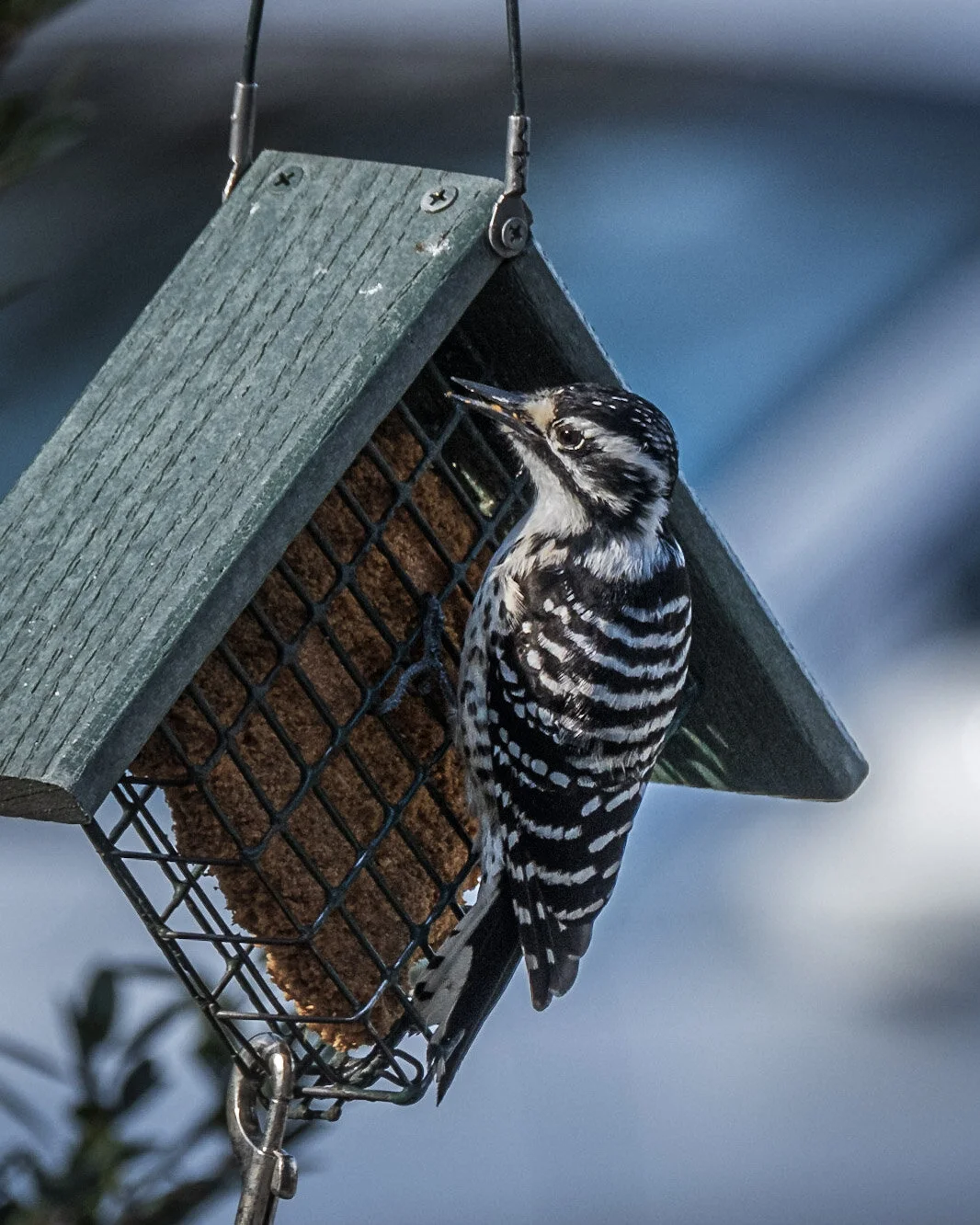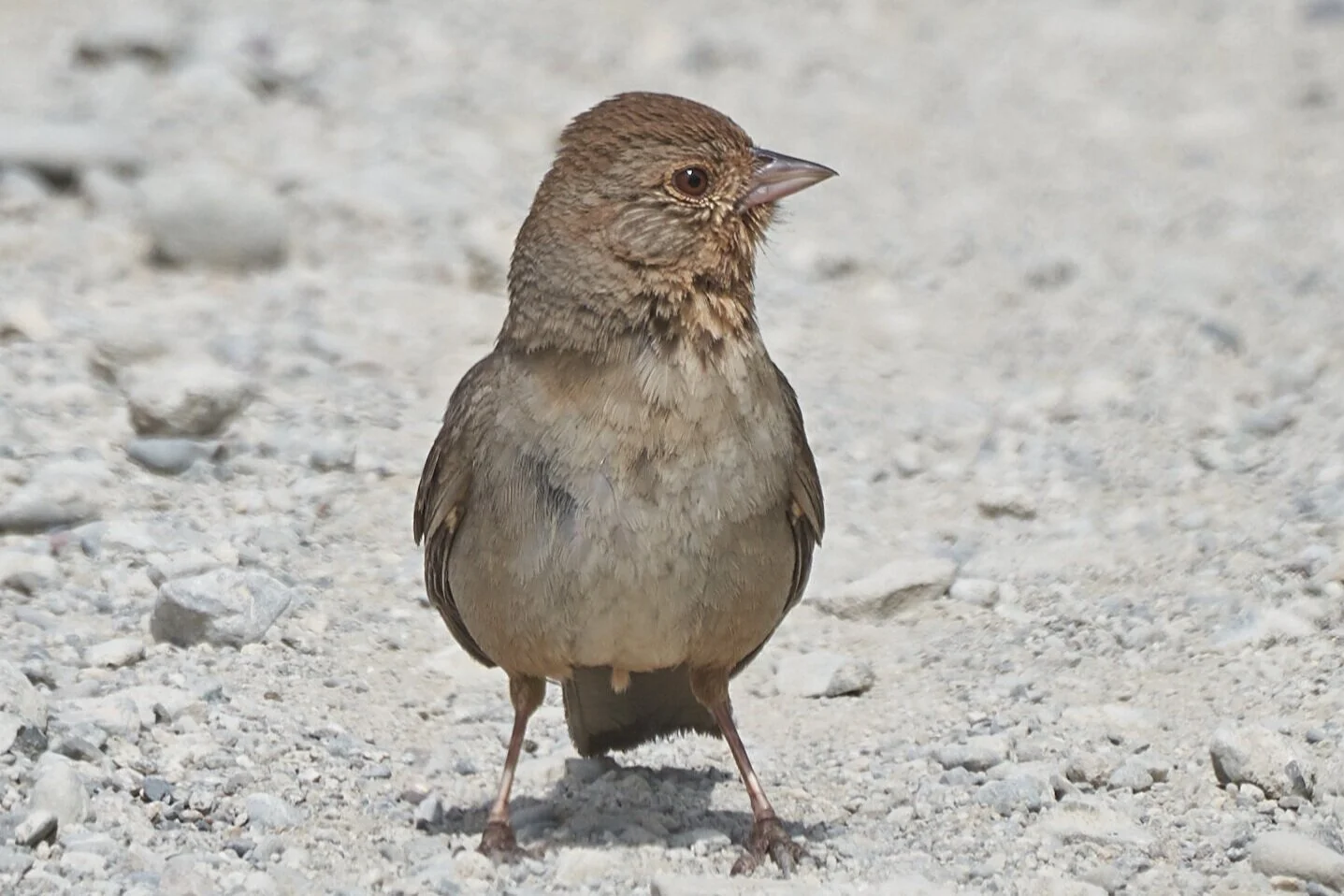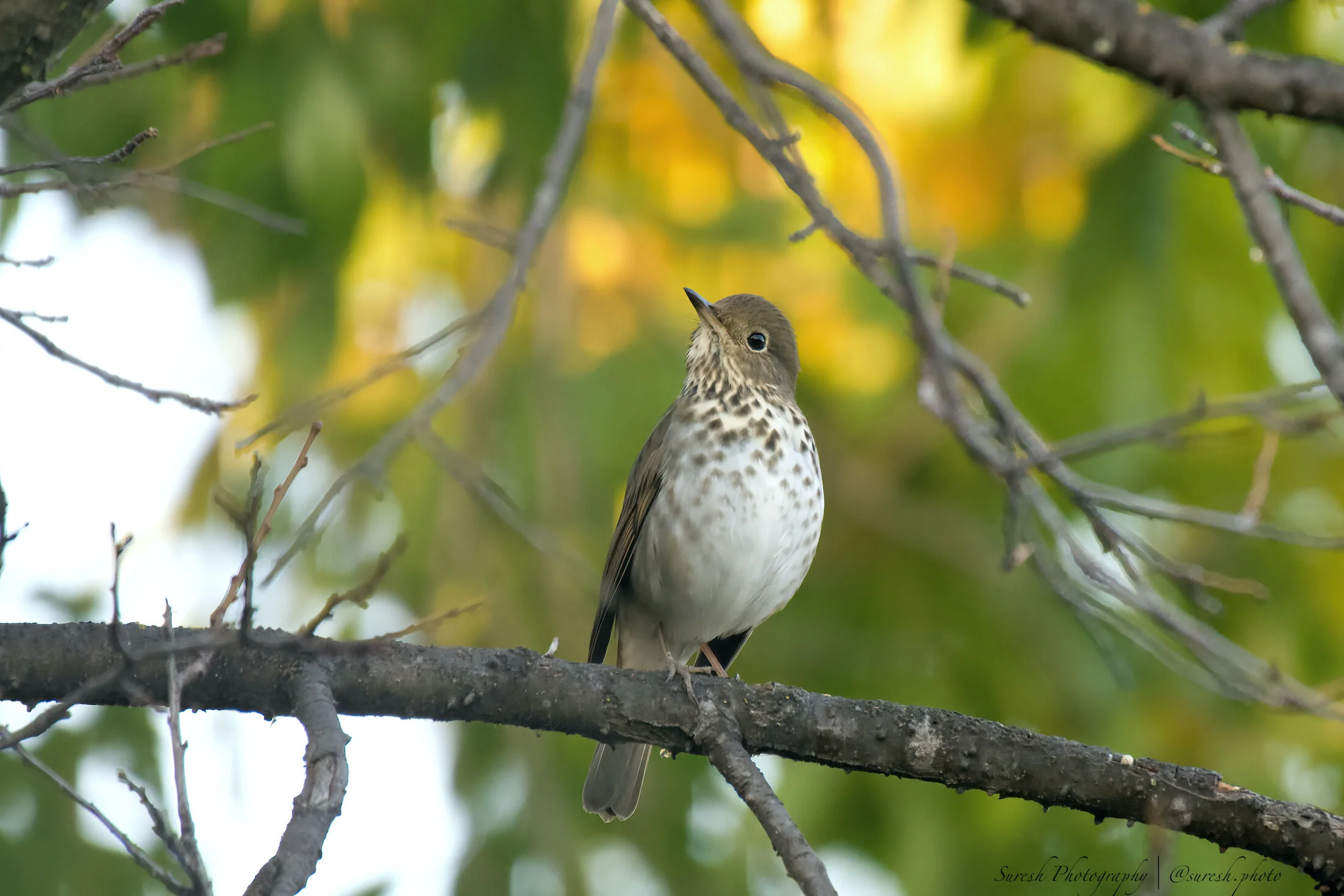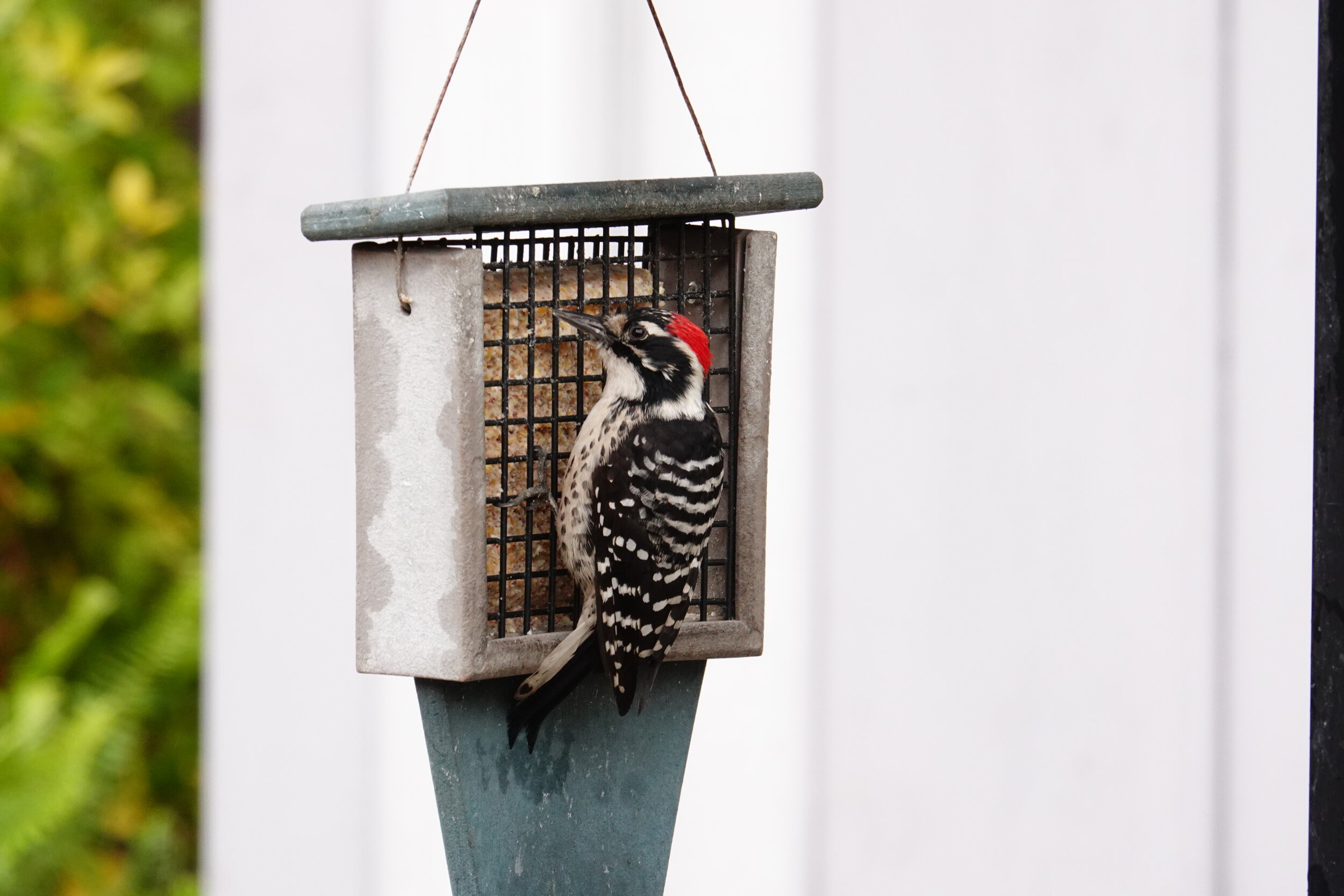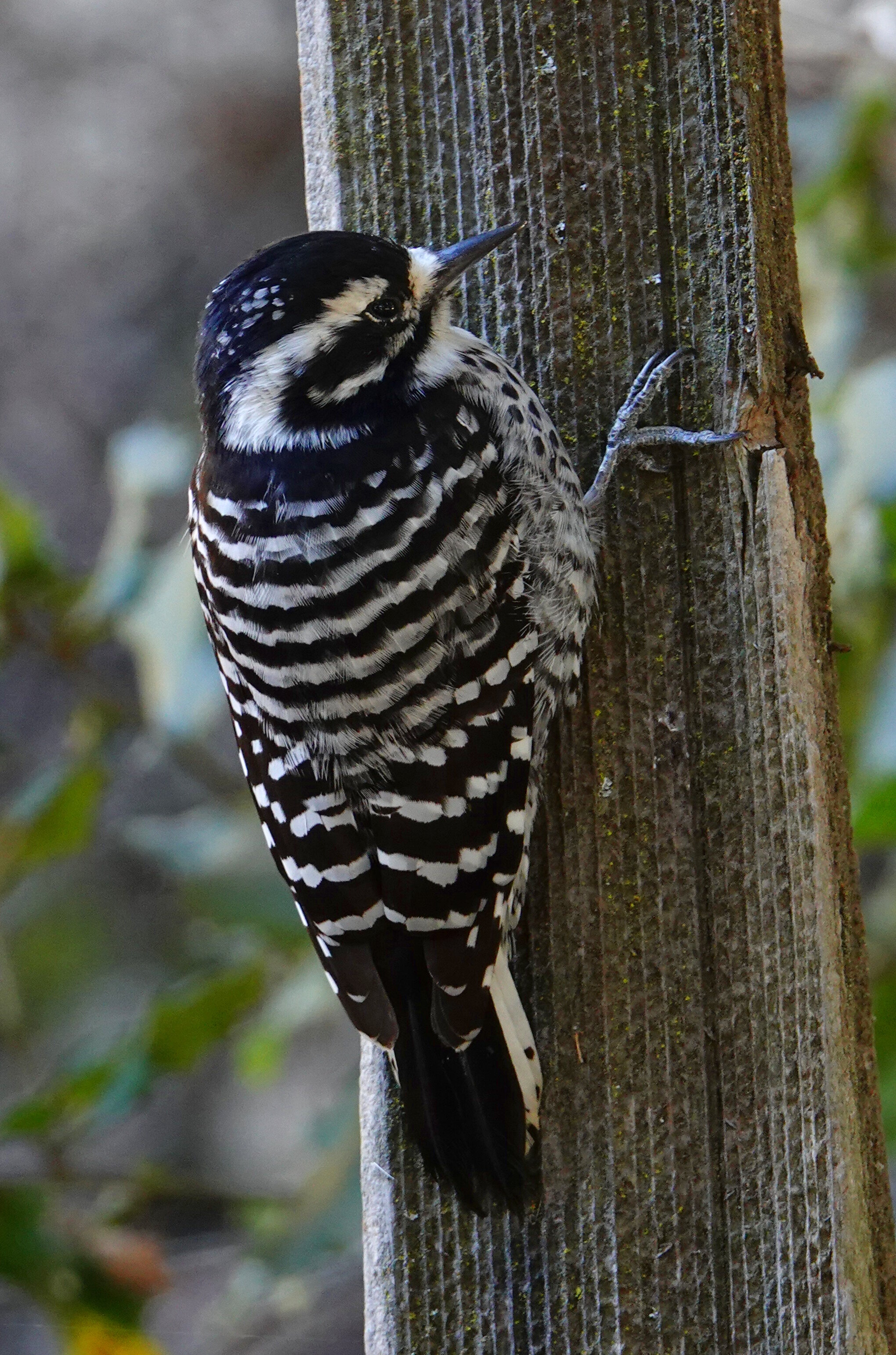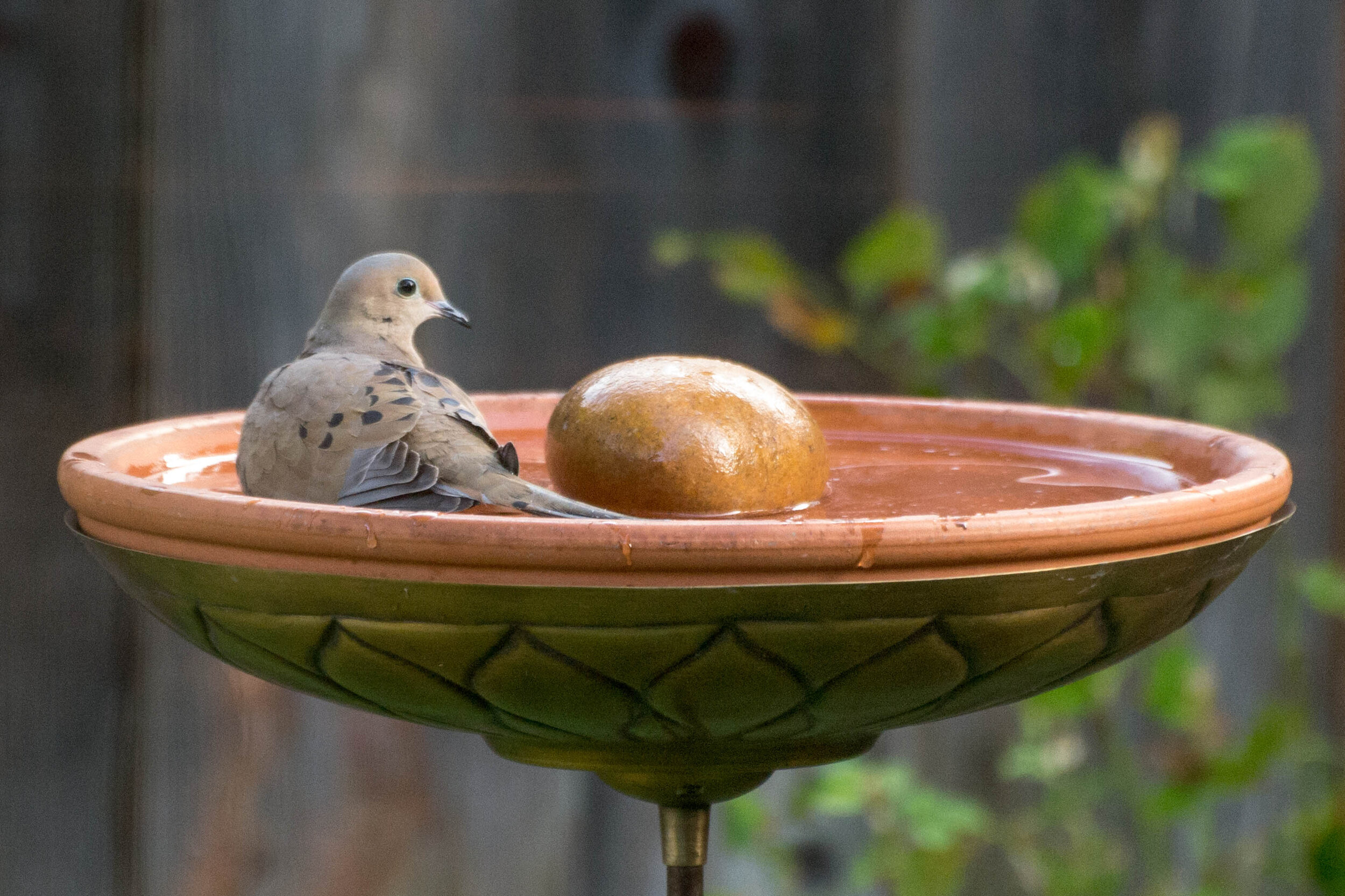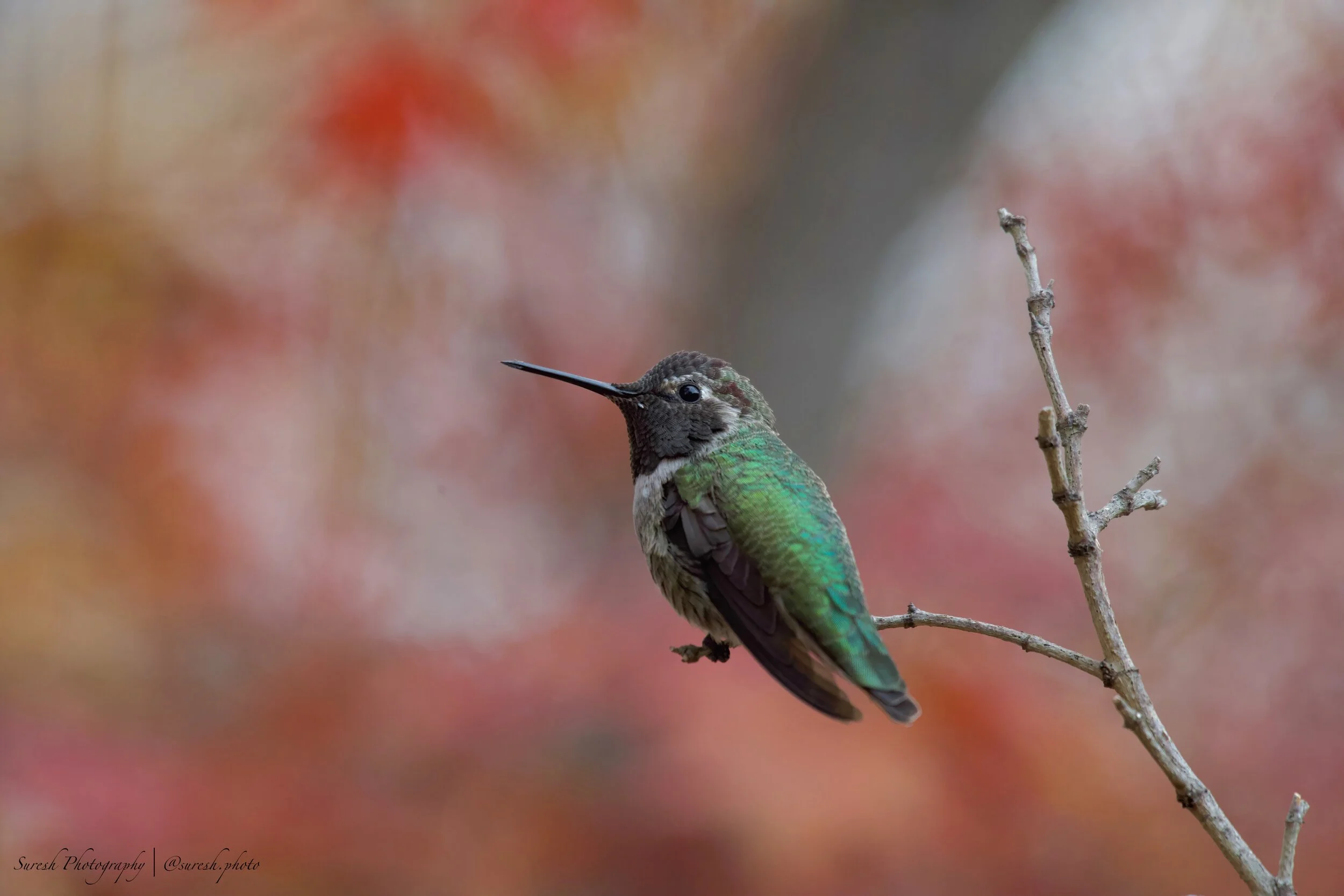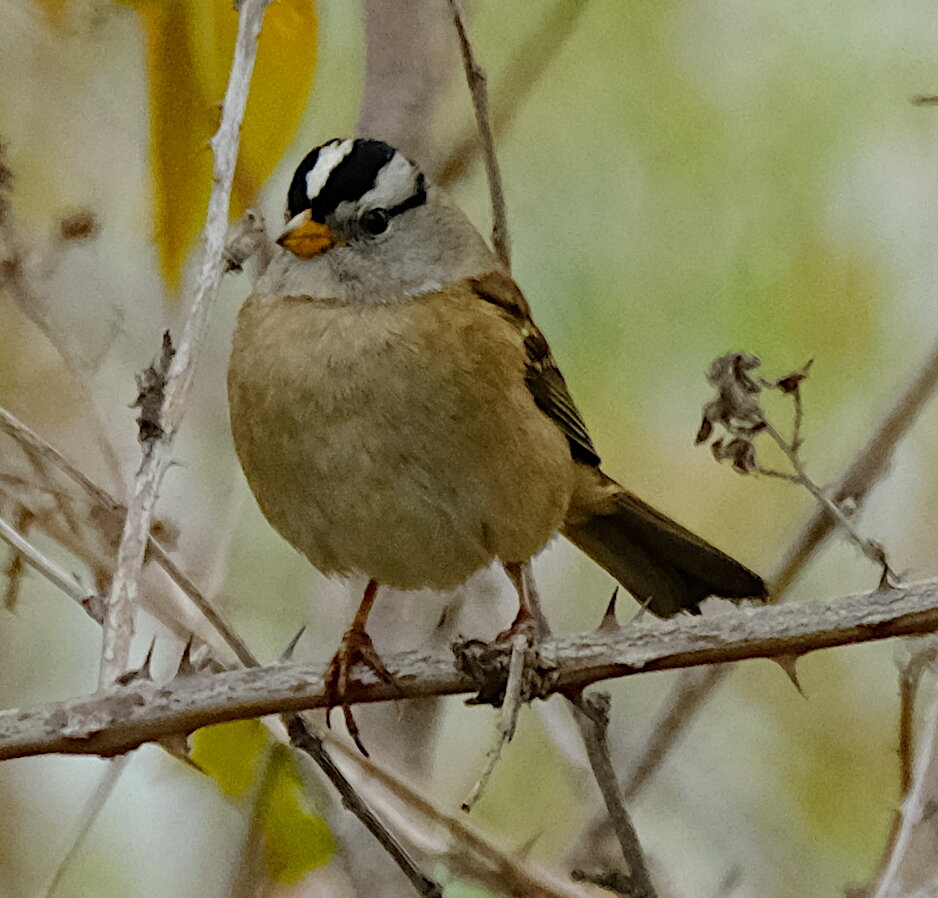Spring is here and the birds are nesting! Find out what birds our members and friends have seen lately in their yards and neighborhoods.
White-breasted Nuthatch
White-breasted Nuthatch
by Dave Zittin
When Floy and I introduced our grandson to the White-breasted Nuthatch, he named it the “upside-down bird” because it descends trees headfirst. This small agile bird is constantly on the move either foraging or defending its territory. It is quite the arboreal acrobat. When it stops its descent, it often holds its head outward, away from the tree giving it an “L” shaped profile. It can also cling to the bottom of horizontal branches in its frantic search for food. This species prefers old deciduous or mixed deciduous forests, but if your backyard is close to trees, you will likely find it there.
White-breasted Nuthatch, the “upside-down bird”. Tom Grey
Most individuals of this species are non-migratory and occur in Santa Clara County throughout the year. Nuthatches cache seeds in the bark crevices of trees so keep an eye out for an individual going back and forth from a feeder to a tree where it pounds the food in a crevice then returns to gather another seed to add to its food cache. Nuthatches are monogamous cavity nesters. The male feeds the female when she is incubating the eggs. A male-female pair will inhabit a very large territory, which can be in excess of 25 acres and they will defend it throughout the year to prevent other White-breasted Nuthatches from raiding their cache.
Attracting White-breasted Nuthatches to Backyards
Like most of our birds, White-breasted Nuthatches are omnivorous and they will eat fruits, seeds and insects. Suet or seed feeders will attract them to backyards. I commonly see them on our seed feeder working their way upside down to the feeding holes. They are unable to crack seeds with their beaks like finches, so they grab a seed and pound it into bark crevices and either leave it there for future consumption or continue pounding it in order to crack open the seed and ingest the pieces.
White-breasted Nuthatch on suet feeder by Curt Bianchi
Description
The White-breasted Nuthatch is a compact bird with a short tail. The back is mostly a pretty blue-gray color and the under tail coverts are rusty-red. The sides are varying degrees of white and reddish. The narrow cap is black and the face is white.
White-breasted Nuthatch with hint of reddish sides. Brooke Miller.
Sounds
White-breasted Nuthatches can be very noisy and I think of them as sounding “boisterous”. It fascinates me that such a tiny bird can make so much noise, but it makes this racket to communicate with its mate, to let intruders know that they are entering an occupied territory and for other purposes.
The most common sound I hear from the White-breasted Nuthatches in our backyard is the nasal “yank” or “quank” call. No other bird makes a sound like this in our county. You can hear their common sounds here by listening to the two recordings labelled with a parenthetical “(Pacific)”.
White-breasted Nuthatches are found over much of the U.S. Their northern range extends into southern portions of Canada. Their southern distribution is over the mountains of Western Mexico south into the state of Oaxaca.
Similar Species
There are three species of nuthatches in Santa Clara County: White-breasted, Red-breasted and Pygmy Nuthatch. They are easy to tell apart by looking at the eye and the facial patterns. The eye of the White-breasted Nuthatch is surrounded by white feathers. The Red-breasted Nuthatch has a conspicuous black stripe through the eye with white above and below. The dark-brown cap of the Pygmy Nuthatch extends to just below the eye and there is no white at all touching the eye.
White-breasted Nuthatch by John Richardson.
Pygmy Nuthatch by Tom Grey.
Red-breasted Nuthatch by Dave Zittin.
Explore
All About Birds: White-breasted Nuthatch
Audubon Field Guide: White-breasted Nuthatch
More Backyard Bird Information
View more common Santa Clara County Backyard Birds
Visit our Backyard Birding page
Read our Notes and Tips from a Backyard Birder series
Tell us what you’re seeing in your yard! Send your notes, photos, and sound clips to backyardbirds@scvas.org. We’ll feature your submittals on our website.
Banner Photo: White-breasted Nuthatch by Hita Bambhania-Modha
TWO IN A BUSH
ALL AROUND TOWN
CHANGE IS IN THE AIR
Bewick's Wren
Bewick’s Wren
by Dave Zittin
Bewick's Wren is a small, hyperactive bird with an attitude that suggests it is the king of your backyard. It is the most common backyard wren of Santa Clara County. John James Audubon named this wren in the 1820s after his friend Thomas Bewick, who was a British wood engraver and natural history author.
Backyard Bewick’s Wrens
Bewick's Wrens prefer shrubby areas and gravitate to backyards if food is present. Lawn furniture, picnic tables and wood fencing help attract this wren because spiders and insects inhabit these structures. This wren prefers to eat small arthropods and arthropod eggs, but it will feed on suet blocks and seeds, either in feeders or on the ground.
In my backyard, our resident Bewick's Wren is out almost every morning scouting in and around a wood deck for insects, then traveling back and forth between our suet feeder and the seeds I throw on the ground.
Bewick's Wrens may use backyard nesting boxes. See Cornell's NestWatch website for more information.
Bewick’s Wren looking foraging along a rock wall. Photo by Brooke Miller.
Description
A wren is a wren and it's hard to mistake a local wren for a non-wren species based on appearances and behavior. Their perkiness and, for most species, a barred and uplifted tail suggest wren, enabling beginning birders to quickly and accurately realize they are viewing a wren.
Most wrens, including Bewick's Wren, have long beaks that curve downward (decurved beak) and have subtle but beautiful color patterns. Bewick's Wrens have upper parts that are a rich, warm reddish-brown color. The throat and underparts are whitish and the flanks (sides) are gray. The tail has many regularly spaced dark brown cross stripes. The face shows a distinctive bold white eyebrow (supercilium).
Notice the decurved bill, thick white supercilium, and the barred uplifted tail of this Bewick’s Wren. Photo by Dave Zittin.
Sounds
The calls and the songs of the male Bewick's Wren is complex and highly variable. Just when I think I understand their sounds, they seem to invent a new one to throw me off. Only the males sing. They learn their songs from other males on neighboring territories from 60 to 90 days after they fledge, not from their fathers. Individuals can have as many as 22 different songs.
Bewick’s Wrens are just starting to sing in my backyard. A call I often hear is the one I’ve named “the electronic raspberry”, the wren version of a raspberry: bzzzzt. Click on the various calls link near the bottom of the Audubon: Bewick’s Wren page to hear the electronic raspberry. You can hear additional songs and calls on the All About Birds: Bewick’s Wren Sounds page. Our county Bewick's Wren belongs to the "spilurus group", so be sure to listen to the call and song from that group. Note the Geiger counter-like sound of the spilurus group call. This is one of many calls, but I commonly hear this one in my backyard. The spilurus song sample reminds me of a backwards Song Sparrow's song. It starts with a complex beginning with trills and tone changes then ends with 4-5 more or less clear whistle tones.
Singing Bewick’s Wren with plain gray flanks. Photo by Suresh Thirumalai.
Distribution
A century ago, Bewick's Wren was common in the Eastern U.S., but its numbers declined as the House Wren expanded its range. Over the past few decades, once common Bewick's Wren sightings became a rare event east of the Mississippi River. Today this species has a complex distribution that is mostly limited to the west coast along most of Baja California, north to Southwestern British Columbia, and a separate portion of its range over several southwestern states and south into Central Western Mexico (range map).
Bewick’s Wrens have very upright tails which they wave about while giving scolding calls. Photo by Dave Zittin.
Similar Species
Santa Clara County has five common wren species; Bewick's, Marsh, House, Pacific and Rock Wren and a sixth uncommon species, the Canyon Wren. When viewing a local wren, examine the face to see if a conspicuous white eyebrow (supercilium) is present. Besides the Bewick’s Wren, there are two other wren species in the county that have superciliums, the Pacific and the Marsh Wren. But neither of these birds will likely be found in suburban backyards because of their unique habitat preferences and their eyebrows are pale and relatively inconspicuous compared to that of a Bewick’s Wren.
Explore
Other local wren species with eyebrows (superciliums)
NestWatch Sites
Sounds and Calls
All About Birds: Bewick’s Wren Sounds
Audubon Field Guide: Bewick’s Wren
More Backyard Bird Information
View more common Santa Clara County Backyard Birds
Visit our Backyard Birding page
Read our Notes and Tips from a Backyard Birder series
Tell us what you’re seeing in your yard! Send your notes, photos, and sound clips to backyardbirds@scvas.org. We’ll feature your submittals on our website.
Banner Photo by Curt Bianchi
ALL AROUND TOWN
Cooper's Hawk
Cooper’s Hawk
by Dave Zittin
The Cooper's Hawk is a member of the genus Accipiter, a group of hawks that have short, broad wings and long tails that are adapted for fast flight in wooded areas. They have fantastic maneuverability in high-speed flight pursuits of prey. They maneuver through trees, brush and around other obstacles with remarkable agility. To protect themselves after capturing prey with their sharp, long talons they hold the captured prey away from their body until it dies. Sometimes these hawks will drown their prey.
Cooper’s Hawks are usually found in deciduous and mixed deciduous forest, but this species has proven to be adaptable to life in urban, suburban and agricultural environments. They are probably the most common backyard raptor in the United States.
This hawk was named by Charles Bonaparte after a friend and fellow ornithologist, William Cooper in 1828.
Cooper’s Hawk by Dave Zittin.
Backyard Cooper’s Hawks
Bird feeders attract Cooper's Hawks. If you have large numbers of birds feeding in your backyard you will likely attract this hawk which kills and eats Mourning Doves, Robins, Jays and more. Their preferred prey are birds of small to medium size, but they will capture and eat small mammals too. We have observed several Mourning Dove kills by Cooper's Hawks in our backyard. Birds will instantly leave a feeding area in rapid flight and disappear as if by magic if they sense a Cooper's Hawk is nearby. If you want to get rid of a Cooper's Hawk that has taken up residence in your backyard, remove your feeders for a few days and it will likely go elsewhere.
Cooper’s Hawk at bird bath. Photo by Myron Meier.
Description
Cooper's Hawks are crow-sized. This species is characterized by short, rounded wings and relatively long tail, which has a rounded end. Their legs are yellow. The adult has a beautiful barred, rufous-colored breast.
The male is smaller than the female. The length of the female ranges from 14.6 to 15.3 inches, about 10 – 20% longer than the male. The male weight range is 7.8 to 14.5 ounces. The heavier female has a weight range of 11.6 to 24.0 ounces.
The young bird resembles the adult in shape, but the back is browner in color, often with white checkering that is absent in the adult and it has brown streaking on its breast. Some of the streaks have a distinctive teardrop shape. The color of the iris of a young bird is yellow and turns orange to red in color as the bird matures.
Juvenile Cooper’s Hawk with Mourning Dove. Note the teardrop shape of the breast streaking and yellow iris. Photo by Dave Zittin]
Distribution
Cooper's Hawks are found across the entire continental United States and south into Central America throughout the year. In the breeding season some adults migrate north into Southern Canada. Non breeding populations occur across most of Mexico and south into Central America throughout the year.
Similar Species
The less common Accipiter species in Santa Clara County is the Sharp-shinned Hawk. Cooper's and Sharp-shinned Hawks are very similar in appearance and present an identification challenge, but with experience, one can distinguish the two.
Sharp-shinned Hawk by Dave Zittin
On roosting birds note the head shape. The Cooper's Hawk's head appears squared off with the top of the head flattened and a distinct almost 90 degree angle forming between the top of the head and back of the neck. The Sharp-shinned has a more rounded head with a continuous arc starting at the upper mandible (beak) continuing over the head and down the nape. The Sharp-shinned Hawk has a relatively smaller head and sometimes appears to lack a neck. The adult Cooper's Hawk has a very dark cap that ends at the angle between the top of the head and neck which presents a sharp color contrast between the top of the head and the lighter nape. While the color of the top of the head of the Sharp-shinned Hawk's head is dark, it continues down onto the nape with no change in color.
Cooper’s Hawk with flat head and sharp angle from top of head onto nape. Photo by Dave Zittin.
Sharp-shinned Hawk with curved head, short neck and dark cap extending onto nape. Photo by Dave Zittin.
In flight the head of a Sharp-shinned Hawk rarely extends beyond an imaginary line from wrist-tip to wrist-tip, but the head of the Cooper's Hawk extends well beyond the leading edges of the wings.
If you see a squared tail end, it's probably a Sharp-shinned Hawk. If you see a rounded tail end it might be a Cooper's or a Sharp-shinned Hawk as the Sharp-shinned Hawk's tail end can become rounded with wear.
Explore
Photo of Cooper’s Hawk carrying Cattle Egret
All About Birds: Cooper’s Hawk and Sharp-shinned Hawk
More Backyard Bird Information
View more common Santa Clara County Backyard Birds
Visit our Backyard Birding page
Read our Notes and Tips from a Backyard Birder series
Tell us what you’re seeing in your yard! Send your notes, photos, and sound clips to backyardbirds@scvas.org. We’ll feature your submittals on our website.
Banner Photo by Binu John
THE HABIT OF COUNTING BIRDS
The Great Backyard Bird Count (and Competition)
ALL AROUND TOWN
California Towhee
California Towhee
by Dave Zittin
The California Towhee is the largest sparrow found in our area. This species is non-migratory and is here throughout the year. California Towhees are territorial during breeding season and are often seen sparring with their reflections in windows and car mirrors. They show strong pair bonding. Frequently we see two at a time feeding in our backyard.
California Towhee by Dave Zittin. Notice the cinnamon colored throat.
Attracting California Towhees to Backyards
Like other bird species in our area, California Towhees are omnivorous. They specialize in eating seeds and fruits but they will also consume insects. Although they seem to prefer eating off of the ground, I have seen them on suet and hanging seed feeders.
Description
The California Towhee is a large, plain sparrow belonging to the genus Melozone. This species is mostly gray-brown in color. The wings and the top of the head (crown) can be a little darker than the rest of the body. The under tail coverts and the areas immediately around the eyes and the throat are a warm, cinnamon-brown color. The cinnamon throat often contains dusky spots or streaks.
California Towhee with rufous under tail coverts. Photo by Dave Zittin
Distribution
The California Towhee ranges from the Southern Oregon border south to the southern tip of Baja California. In California it occurs mostly in the western half of the state. In natural areas they occur in chaparral scrub lands and in riparian areas. California Towhees are often encountered feeding at trail edges where they can retreat into brush if threatened. They also do well in suburban backyards whenever there is food, water and plants which can provide safety.
Similar Species
There is one unrelated species that resembles the California Towhee, the California Thrasher. Both are large brown birds that are often seen feeding off of the ground. However, the California Thrasher is larger and has a very long down curved bill which it uses to thrash and turn over leaf litter as it forages for insects. The bill of the California Towhee is short and conical. The California Towhee uses both feet at the same time, not its bill, to turn over ground litter in search of food. There are eight species in the genus Melozone, three of which occur in the United States. The other species are found from Mexico and south into Central and South America. There is only one species of Melozone in our area, the California Towhee.
California Towhee by Brooke Miller
California Thrasher pair by Janna Pauser
Explore
California Towhees have a distinct metallic “clink” call. Listen to it by visiting the “Sounds” tab at:
All About Birds: California Towhee
More Backyard Bird Information
View more common Santa Clara County Backyard Birds
Visit our Backyard Birding page
Read our Notes and Tips from a Backyard Birder series
Tell us what you’re seeing in your yard! Send your notes, photos, and sound clips to backyardbirds@scvas.org. We’ll feature your submittals on our website.
Banner Photo by Carter Gasiorowski
Project Feederwatch
A YEAR OF GRATITUDE AND HOPE
ALL AROUND TOWN
Nuttall's Woodpecker
Nuttall’s Woodpecker
by Dave Zittin
Eight species of woodpeckers occur in Santa Clara County. In suburban areas, the Nuttall's Woodpecker is the most common backyard visitor.
Male Nuttall’s Woodpecker. Note the white barring pattern on an otherwise black back. Photo by Tom Grey
Attracting Nuttall's Woodpecker to Backyards
Most woodpeckers are omnivorous. The Nuttall's Woodpecker's diet is composed mostly of insects, but it will eat seeds, berries and other fruits. This woodpecker uses its feet and stiff tail feathers to prop itself while feeding. From my experience a suet feeder with a “paddle” that extends well below the suet block so that the bird can use its tail feathers for support is best. I have had luck attracting woodpeckers using suet containing dried insects. During the summer, Nuttall's Woodpecker is a common visitor and I will see one on the feeder several times each day. Often this species will “announce” its arrival with a loud metallic rattle call.
Male Nuttall’s Woodpecker at a suet feeder with a “paddle”. The paddle extends well below the suet block so that the woodpecker can use its tail feathers to support itself while feeding. Photo by Dave Zittin.
Descriptions
Nuttall's Woodpecker can be distinguished from our other local woodpeckers by a white barring pattern on an otherwise black back. The mature male has a white and black streaked forehead and a large red patch that covers the entire rear of the head. The top of the female's head is black. Immature birds resemble adults except that both sexes can show red on their crowns, but it does not extend down the back of the head as it does in the adult male (see the banner photo on the top of this page.)
Female Nuttall’s Woodpecker. She lacks the red crown of the male. Photo by Dave Zittin.
Distribution
Nuttall's Woodpecker is truly a California species and is found almost exclusively in this state with a small population in Northwest Baja California. This species prefers oak woodlands and riparian areas, but it occurs wherever there are trees and has done well in populated areas.
Similar Species
There are two other species that beginning birders might mistake for Nuttall's Woodpecker, the Hairy Woodpecker and Downy Woodpecker. Both of these species have a prominent white streak in the upper center of their backs instead of a black back with white stripes that is seen on the Nuttall's Woodpecker.
Downy Woodpecker. Note the lack of barring on its back and its tiny bill. Photo by Peter Hart.
Female Hairy Woodpecker. Note the prominent white streak on its back. Photo by Peter Hart.
Explore
In the “sounds” section in the references below, be sure to listen to the characteristic metallic “rattle” call of Nuttall's Woodpecker.
All About Birds: Nuttall’s Woodpecker
More Backyard Bird Information
View more common Santa Clara County Backyard Birds
Visit our Backyard Birding page
Read our Notes and Tips from a Backyard Birder series
Tell us what you’re seeing in your yard! Send your notes, photos, and sound clips to backyardbirds@scvas.org. We’ll feature your submittals on our website.
Banner Photo Credit: Immature Nuttall’s Woodpecker by Brooke Miller
Pine Siskins Galore...and More!
Pine Siskins Galore...and More!
BY JULIE AMATO
Finally, it has rained. Brisk north winds, cloudy skies, and a damp chill ushered in the first good storm of the fall, and I woke one morning to a gleaming wet yard and the rhythmic tap of water dripping in the gutters. With the heat and smoke of recent months barely behind us, the change is welcome.
Winter is fast approaching, and as the temperatures drop more at night, and the humidity goes up, I am seeing more and more birds in my yard, availing themselves of the food on offer. There is an increasing number of species, including new winter arrivals, as well as a growing number of individuals, all of which is shaking up the pecking order and leading to some ruffled feathers.
Recent highlights in our yard
Pine Siskin in our yard
Pine Siskins are here! One bird snuck into the mix at our hopper feeder in early November, and it has been back with its cohorts nearly every day since. At first, this little finch can be hard to tell apart from a House Finch: look for heavy striping, with greater contrast between the stripes and the rest of the body than a House Finch has; a thin pointed bill (the House has a thick conical one); and a mesmerizing burst of lemon-yellow color when it opens its wings. When the bird is at rest, a thin yellow line can sometimes be seen along the edge of the wings, as in the picture above.
Siskin “tolerating” House Finches at our bird bath
This is an irruptive year for Pine Siskins, which means that large numbers of these migratory birds have descended from Canada to spend the winter here. In fact, the National Audubon Society says that this may be a record-making year for Siskins and that you can find them virtually everywhere in the U.S. If you haven’t seen them in your yard before, keep an eye out for them this winter!
Siskin shows a Lesser Goldfinch who’s boss
With the weather getting colder and wetter, there are more squabbles among the birds at my feeders. While working in my home office, I frequently witness explosions of wings, feathers, and angry chatter, as various members of the finch family jockey for who’s on first: House Finches, Lesser Goldfinches, American Goldfinches, and Pine Siskins all vie simultaneously for prime positions on the hopper feeder. The Houses usually win, although if the smaller Lessers show up in a group, they can sometimes dethrone the other birds. The Siskins are small but mighty, and will defend their positions by jabbing their heads in the direction of interlopers and telling them to back off!
Hermit Thrush in our yard, at a shy moment
Other birds have startled me with unexpected shows of aggression. One morning a Black Phoebe and a Hermit Thrush were foraging in the same corner of the yard. Suddenly the Phoebe flew directly at the Thrush, which quickly left the scene. That was that, I thought, but a minute or two later, the Thrush had returned, perching peaceably enough on the fence - until it abruptly dive-bombed the Phoebe and drove it away! I wouldn’t have thought that these two species would have it in for each other, but on this particular cold, wet day, perhaps some resource competition was going on. Or maybe these two birds just personally disliked each other?
Brown Creeper, doing what it does best - creeping!
In other news, I saw my first Brown Creeper in a while, when movement in a street tree caught my eye while I was at the kitchen sink. I raced out, hands dripping wet, and managed to get there on time to snap a few pictures as the bird hopped up and down and around the trunk, at gravity-defying angles, probing for insects (the camera got damp but survived).
American Goldfinch, with Lesser Goldfinches and a House Finch (don’t be fooled by the serenity of the moment!)
American Goldfinches have made their seasonal debut in our yard as well. If your mental image of an American Gold is of a brilliant yellow bird, you would be right - but only in the summer months. In the winter, look for a dramatically different bird, one that is mostly a muted beige, with some yellow on the face and neck, and bold white stripes on black wings. This is the American Goldfinch’s non-breeding plumage.
Of course, all of our regular visitors are also here. Flocks of Mourning Doves forage at dusk before flying to a nearby tree to roost for the night. California Scrub-Jays come to snatch peanuts. Bewick’s Wrens specialize in gleaning insects from the nooks and crannies of the structures in our yard - the fence, the eaves, and lately, the grooves and edges of the paved patio. White-crowned and Golden-crowned Sparrows fill the yard at dawn, dropping through the branches of the blue potato bush like rain. I suspect they cause some trepidation among our year-round resident sparrows, the Dark-eyed Junco and the California Towhee, who haven’t been as visible in the yard since the crowned sparrows arrived for the winter.
What to look for in December
In addition to our year-round residents and early winter arrivals, expect to see many of the birds I introduced for the month of November, including Ruby-crowned Kinglets and Yellow-rumped Warblers.
Woodpeckers are active throughout the winter. The Nuttall’s Woodpecker is our Backyard Bird of the Month right now. Almost exclusively found in California, it is common in suburban areas, where you will often find one drumming away on a utility pole.
Listen also for the squeaky kyeer and wicka-wicka calls of the Northern Flicker, which is also in the woodpecker family. Although Flickers will forage on the ground, I have usually found them in tall trees in my yard. They haven’t shown up at our place yet, but we did see two while walking around the neighborhood recently.
One December, we saw a Bald Eagle soaring high in the sky above our home. While these birds can be seen year-round in our county, I usually spot them in flight during the winter months. Step outside and look up!
Cedar Waxwings - delightful masked bandits, with red drops on their wings like sealing wax - should be seen more frequently and abundantly now. The December high count in my yard is 35 of them. These highly social birds can be a bit unpredictable at any location - as fruit eaters, they wander in search of ripe fruit and berries, and can show up unexpectedly. I am still waiting to see my first Waxwing this winter!
Male House Finch with a gleaming ruby forehead
If you have feeders, expect an uptick in House Finches as the weather gets colder - note how the males’ feathers are getting redder and redder. Look also for increasing numbers of Pine Siskins at your feeders and bird baths.
Mourning Dove hanging out in the bird bath
Scattering seed on the ground will attract abundant ground feeders like Mourning Doves and members of the sparrow family, especially White-crowned and Golden-crowned Sparrows. Chestnut-backed Chickadees, Oak Titmice, and White-breasted Nuthatches are fewer in number, but nevertheless faithful feeder visitors throughout the winter.
Getting into backyard birding
It’s fun to see how birds of different species relate to each other. Dominance hierarchies (who is bolder than whom, and who displaces whom at feeders) have been studied using data from Project FeederWatch. Usually the bigger birds win - but not always! Read this article to find out the competitive “ability scores” of common feeder birds, and see if they match your observations in your yard.
What birds are in your yard?
What are you seeing and hearing in your yard now? All observations are good, and species ID’s aren’t necessary! (In fact, we can help with that.)
Drop us a note or send a photo or sound clip to backyardbirds@scvas.org. We’ll share your submittals in our new feature, All Around Town.
More resources
This winter, count birds at home for science! Project FeederWatch, a citizen science project of the Cornell Lab of Ornithology, is now underway for the season. For information about how to participate, see the FeederWatch website.
For more information about backyard bird feeding, see our Backyard Birding page.
To learn more about backyard bird species, see our list of common backyard birds in Santa Clara County and read all about our backyard bird of the month.
Julie’s Backyard Bird List (October 21-November 22, 2020)
Mourning Dove
Anna’s Hummingbird
Turkey Vulture (flyover)
Cooper’s Hawk
Nuttall’s Woodpecker
Black Phoebe
California Scrub-Jay
American Crow
Chestnut-backed Chickadee
Oak Titmouse
Bushtit
Ruby-crowned Kinglet
White-breasted Nuthatch
Brown Creeper
Bewick’s Wren
Northern Mockingbird
Hermit Thrush
House Finch
Pine Siskin
Lesser Goldfinch
American Goldfinch
Dark-eyed Junco
White-crowned Sparrow
Golden-crowned Sparrow
Lincoln’s Sparrow
California Towhee
Spotted Towhee
Yellow-rumped Warbler
Banner photo by Brooke Miller.
All other photos by Julie Amato.
COUNT BIRDS AT HOME FOR SCIENCE
White-crowned and Golden-crowned Sparrow
White-crowned and Golden-crowned Sparrow
by Dave Zittin
In the fall many migrant bird species leave northern areas and head south to the relatively mild winters of California. Two such species are affectionately referred to as “crowned sparrows”. Adults of both of these species have distinct crown markings which we can use to tell them apart. Both species began returning to Santa Clara County in the past few weeks and are now abundant throughout much of the county. They will remain here until late spring.
Attracting them to backyards
Crowned sparrows love backyards, especially if seed is placed on the ground or on platform feeders and they will eat almost any commercial bird seed mixture. They are opportunistic feeders that will also eat fruits, vegetables, insects and spiders and will ravage emerging garden seedlings. If you have a veggie garden you will want to place a protective covering over the seedlings. I used to lay chicken wire over seedlings to protect them until they were large enough to escape foraging birds.
Description
White-crowned and Golden-crowned Sparrows belong to a small genus of sparrows, Zonotrichia, whose adults have distinct crown patterns and a brown back with black striping. Both of these species have an unmarked, uniform tan-gray breast color. The two species are easily told apart from each other as adults. The adult White-crowned Sparrow has distinct white and black stripes stripes on its crown (the top of the head). The adult Golden-crowned Sparrow has a distinct black crown that is divided at the top of its head, with a golden-colored central area.
Adult White-crowned Sparrow with distinct white and black stripes stripes on its crown. Photo: Dave Zittin
Adult Golden-crowned Sparrow with distinct black crown divided by a golden-colored central area. Photo: Dave Zittin
Telling immature individuals apart is often a challenge for beginning birders, but it's really not difficult. The two species have different beak colors regardless of age. The immature White-crowned Sparrow's bill is mostly a bright yellow or yellow-orange color and if there is any dark color on the bill it is found only as a small spot at the tip of the bill. The Golden-crowned Sparrow has a bill that is a uniform dusky gray color along its entire length and the upper beak is darker than the lower beak.The face patterns of the immature birds also differ. The White-crowned Sparrow's head is boldly striped with brown and creamy buff stripes. Striping is less apparent on Golden-crowned Sparrow's face and there is a small yellow patch on the top of the crown.
Immature White-crowned Sparrow. Photo: Carter Gasiorowski
Immature Golden-crowned Sparrow. Photo: Brooke Miller
Distribution
Both species start their northern migration to breeding grounds, leaving Santa Clara County by the end of April and return to winter here starting in September.
The Golden-crowned Sparrow's distribution is restricted to the westernmost parts of the continental United States, Alaska and Canada. In the winter this species occurs over the west coast of the continental United States. In the summer they range from Western British Columbia north along the coast, SE Alaska and north to cover much of western Alaska. The Golden-crowned Sparrow was a nemesis bird for the gold miners of the 1800s who likened its song to: “I'm so tired” or “No gold here”. “Oh dear me” is another interpretation.
The White-crowned Sparrow has a much wider distribution. In the winter it occurs across much of the southern half of the United States and south into northern Mexico. In the summer breeding season it occurs in the Northern Rocky Mountains, north into Alaska and across Northern Canada all the way to Labrador. There are some populations that do not migrate and an example close to us is on the coast at Half Moon Bay where they are found throughout the year.
Explore
Listen to songs of both species in All About Birds because both species sing outside of their breeding season.
All About Birds: White-crowned Sparrow
All About Birds: Golden-crowned Sparrow
More Backyard Bird Information
View more common Santa Clara County Backyard Birds
Visit our Backyard Birding page
Read our Notes and Tips from a Backyard Birder series
Tell us what you’re seeing in your yard! Send your notes, photos, and sound clips to backyardbirds@scvas.org. We’ll feature your submittals on our website.
Banner Photo Credit: Golden-crowned Sparrow by Tom Grey




















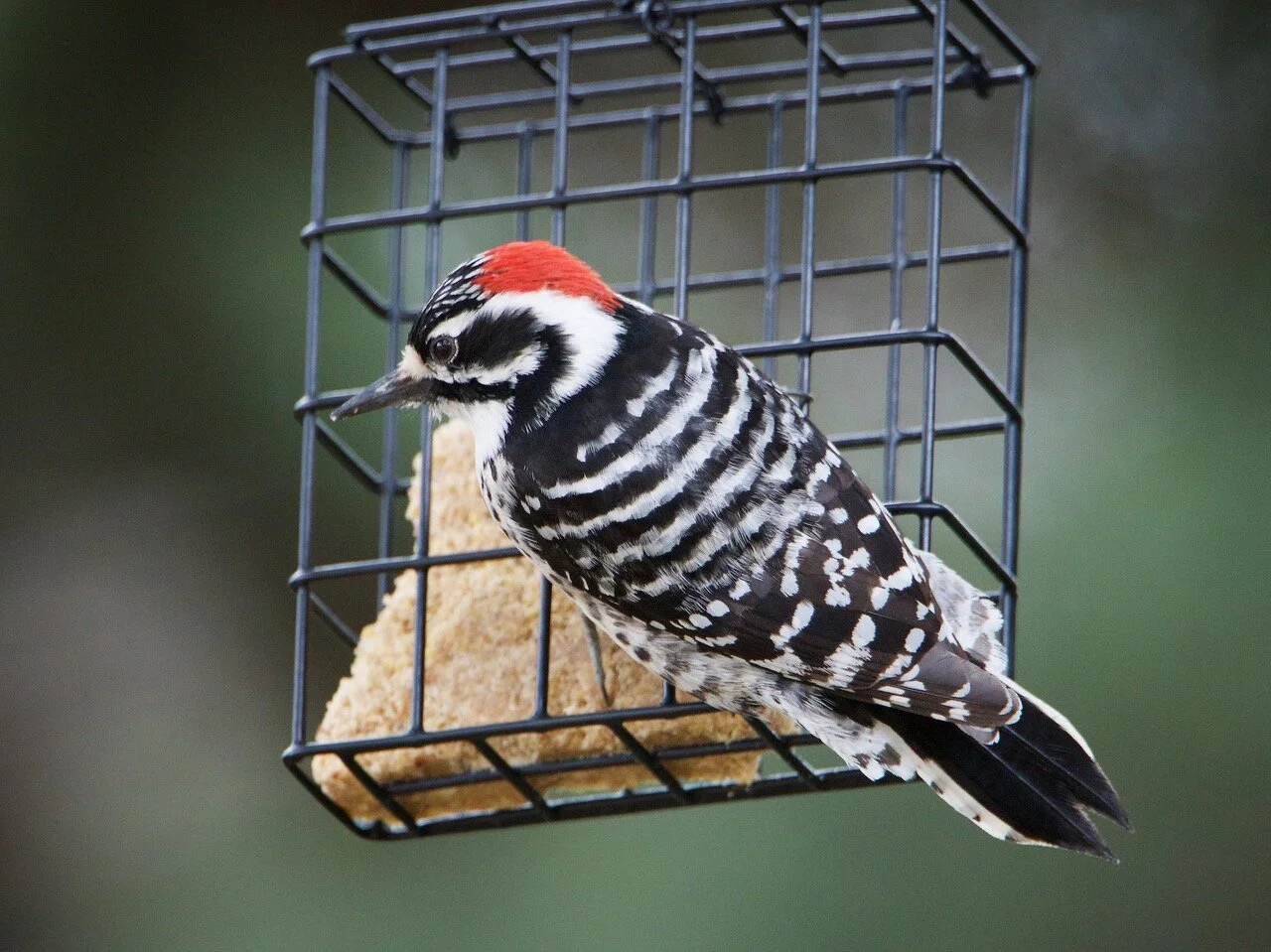
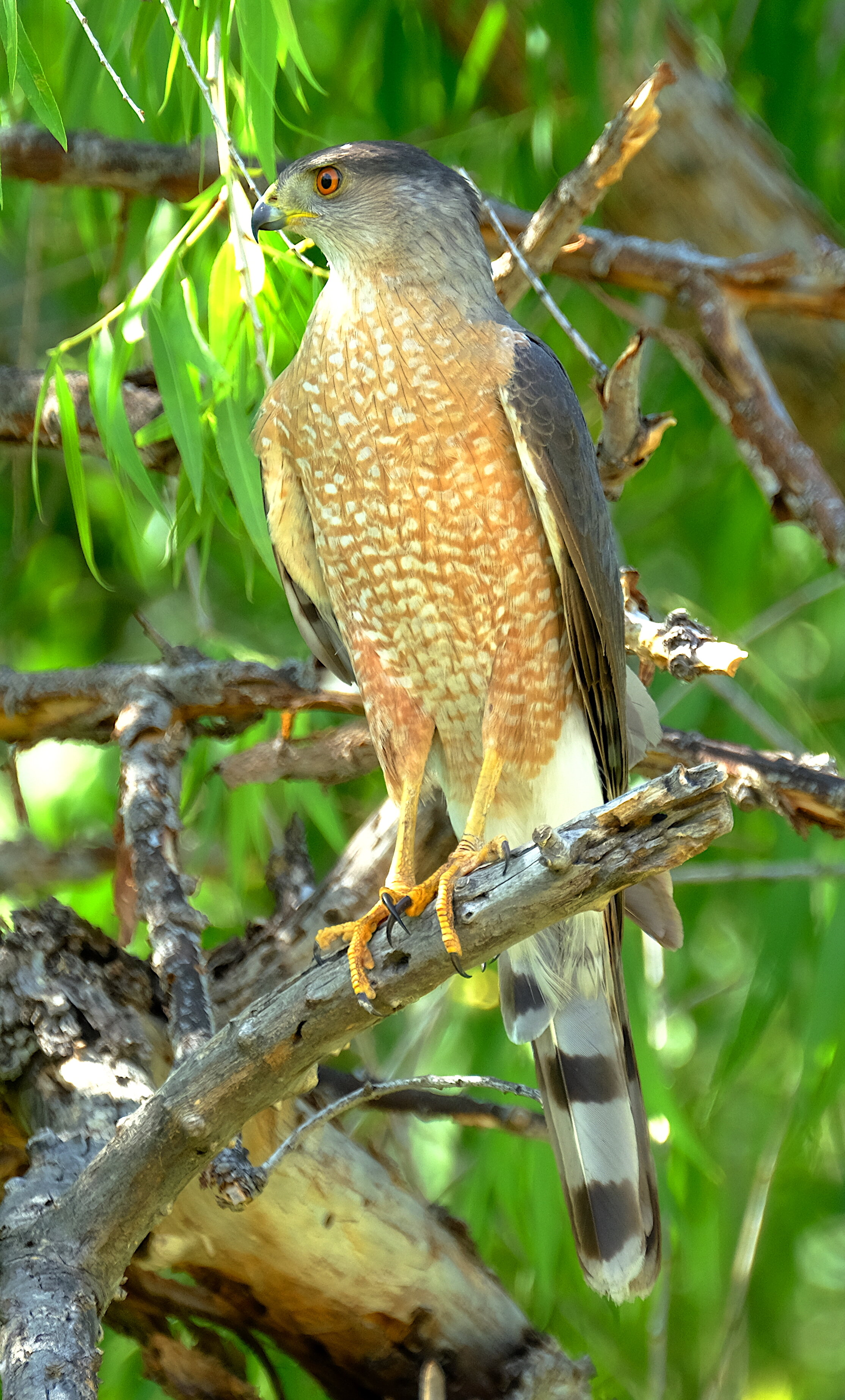

![Juvenile Cooper’s Hawk with Mourning Dove. Note the teardrop shape of the breast streaking and yellow iris. Photo by Dave Zittin]](https://images.squarespace-cdn.com/content/v1/5cc8aba2755be21f06ea88af/1610389534806-X0PXS9UHBZ12THU70ST6/Cooper%27s+Hawk+immature+with+Prey+1+dave+zittin.JPG)




